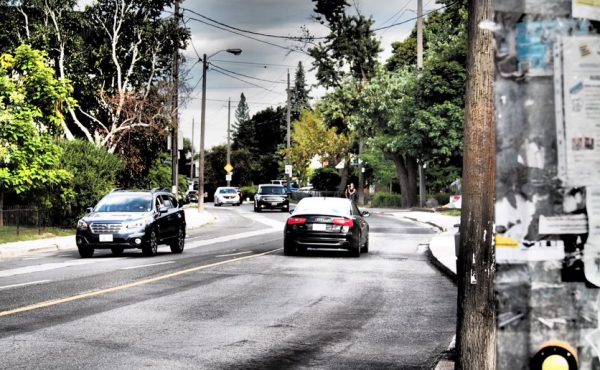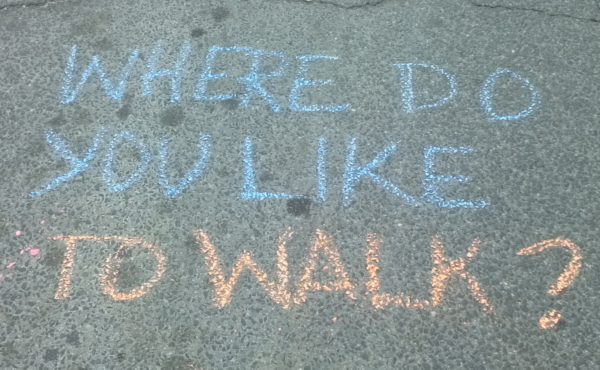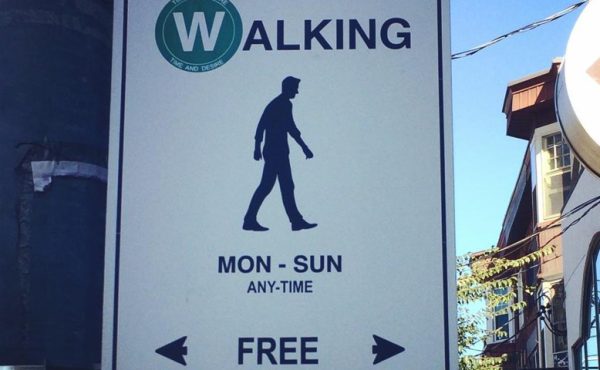We finally have a map of where and how much we walk in Toronto.
As part of Global’s story this week on the most dangerous intersections for pedestrians, their map-maker Patrick Cain put together a simple map showing the City of Toronto’s pedestrian counts (number of pedestrians in one day) for all signalized intersections in Toronto (where there are at least 500 pedestrians a day).
The deeper the red, the larger number of pedestrians — so, not surprisingly, walking is concentrated in the centre of the city. It’s worth noticing, however, that major intersections all over the suburbs also have heavy pedestrian traffic. It’s a myth that there are no pedestrians in the suburbs — there are many, but they don’t show up as strongly because they are more spread out.
If you go to the map itself, you can click on individual intersections to see how heavy the pedestrian traffic is (note that, because the squares are small, clicking on the squares is a bit finicky).
Patrick Cain kindly sent me the list of the 25 most pedestrian-heavy intersections. The surprise is that the intersection with the heaviest pedestrian traffic isn’t downtown, but is in fact Yonge and Eglinton — by quite a wide margin. It suggests that, as many people have proposed (including some of the local councillors), Yonge and Eglinton should be the next candidate for a scramble intersection.
Here is the list of the 25 Toronto intersections with the heaviest daily pedestrian traffic, with their pedestrian counts:
EGLINTON and YONGE: 42680
BAY and DUNDAS: 35585
BAY and WELLINGTON: 32319
DUNDAS and YONGE: 31802
CARLTON and YONGE: 29115
QUEEN and YONGE: 28209
ADELAIDE and BAY: 27086
KING and YONGE: 25743
BLOOR and YONGE: 25696
BAY and BLOOR: 24246
ST CLAIR and YONGE: 24195
UNIVERSITY and YORK: 24056
ADELAIDE and YONGE: 23297
GERRARD and YONGE: 22771
BLOOR and CHURCH: 22634
BAY and KING: 22398
DUNDAS and UNIVERSITY: 21610
HARBORD and ST GEORGE: 21163
BAY and COLLEGE: 21161
JOHN and QUEEN: 20656
WELLESLEY and YONGE: 20133
BAY and QUEEN: 20124
AVENUE and BLOOR: 18872
FRONT and JOHN: 18295
UNIVERSITY and WELLINGTON: 17246
The pedestrian counts are not completely comparable — there are not the resources to do them all on the same day, so they have been done on an ongoing basis, mostly since 2007. All of them are done on weekdays between 7:30 am and 6:00 pm, but the season and the weather varies (which probably affects pedestrian counts more than car counts). Thus, for example, it seems improbable to me that Bay and Dundas gets more pedestrians than Yonge and Dundas (it may also be that Yonge and Dundas gets more walking traffic at night, after the count had ended). So this list is not definitive in terms of the details, but these are certainly useful ballpark figures.
The fact that most of these intersections are downtown is no surpise. What stands out to me is the extent to which Yonge Street really is Toronto’s spine. Ten of the top 25 intersections are along Yonge Street, including both of the intersections that are north of Bloor (Eglinton and St. Clair). The subway certainly has something to do with it, but none of the other subway lines (University/Spadina, Bloor/Danforth, Sheppard) are represented anywhere near as heavily. Yonge is such an unpreposessing street in so many ways, but more of us cross it every day than any other street in the city.
The City of Toronto has had pedestrian counts for all signalized intersections for many years (because they need to do them to figure out how they want to set up the signals) but has never made it easy for anyone to get access to them. It took a freedom of information request to extract them from the City, and journalistic resources to make this information publicly available. It should not have been so difficult to share this useful information.
Now, I am happy to say, Global News has thoughtfully open-sourced the complete data set. I hope others will be able to use it to come up with other interesting insights into walking in Toronto.





6 comments
Yonge and Eglinton is so prominent because it’s the biggest intersection around. Yonge and Eglinton have no competition for foot traffic in the area; downtown, you see splits between Bay/Yonge/Church, Queen/Adelaide, etc. Further, unlike say Bay and King, there’s no extensive underground network to offer an alternate route.
That’s not to say that doesn’t warrant a scramble. But can we please implement it properly? East-west cars with no crossing, scramble, north-south cars with no crossing, scramble. Seeing right turns outside my office at Bay and Bloor hurts my head, and having the scramble only half the time is just dumb.
They did Yonge and Dundas on January 28, 2008 (which was a Monday, and mild for January, with a high just above freezing). It had snowed the previous day. Winter probably affects the totals to some extent.
Agreed that scrambles are not necessarily a bad thing, but they were implemented incorrectly in Toronto (and I’m still skeptical that pedestrian counts in the low to mid 5 digits justify them, 6 digits and we’d be in business). One of the intended benefits of the scramble is to allow vehicles to turn (at least right) in intersections that would otherwise not allow turns, because it’s a scramble and all pedestrian traffic is stopped while vehicles are moving. I’m not sure why not only did Toronto see fit to implement a scramble in an intersection with only 30,000 or so daily pedestrians but also to make it an Irish Scramble.
Yonge/Dundas vs. Bay/Dundas: the counts at Bay/Dundas are from August 2009; at Yonge/Dundas, from January 2008. Therefore, not a surprise that Yonge/Dundas would fall as low as it did. I would suggest that the map is a better tool than the strict numbers, since it shows order of magnitude and geographic trends. The “top 25” list falsely implies a level of comparability (and accuracy!) that isn’t really there.
Suburban intersections: I wonder how much of this has to do with transferring bus riders.
Re. the scramble – at the first one, at Yonge and Dundas, all turns by vehicles were already prohibited. So there was no reason not to allow pedestrians to cross during non-scramble phases. The other intersections being done also have some turning restrictions already in place. The scrambles in Toronto are being introduced as a pedestrian measure, not a vehicle-traffic-management measure, so it makes sense to allow continued pedestrian crossings. The way scrambles are implemented varies from place to place.
I find it very puzzling that, while Bay and Wellington is #3 on the list, Bay and Front is nowhere on it, showing “Average daily pedestrians: 17115”.
It’s not like Wellington is a busy east-west street; those are all people heading to/from Union station, and they have to cross Front to do so. Anyone who has had to do the GO Train salmon run can testify that a huge precentage of GO’s riders pass through Front and Bay. The figures don’t reflect that.
In addition, there are hordes of people crossing from the west side of Bay to the east side, to continue east along Front.
Actually, just pulling up the numbers for Bay St., I have to wonder about the quality of data:
64 8/22/2007 20124 BAY ST QUEEN ST W
63 7/29/2010 11704 BAY ST RICHMOND ST W
62 7/29/2010 27086 BAY ST ADELAIDE ST W
61 4/23/2009 22398 BAY ST KING ST W
60 8/12/2009 32319 BAY ST WELLINGTON ST W
59 4/22/2009 17115 BAY ST FRONT ST W
How come Adelaide and Bay is so much busier than King and Bay? Again, Adelaide isn’t a huge pedestrian corridor, although King St. is. I presume that Union Station commuters are teleporting past Front, appearing at Wellington, then a lot of them teleport past King to appear at Adelaide.
I am also quite surprised that Bay and Dundas is #2.
483 9/20/2007 7260 DUNDAS ST W CHESTNUT ST
36 1/28/2008 31802 YONGE ST DUNDAS ST E DUNDAS ST W
1478 7/24/2000 2820 BAY ST 12m NORTH OF HAGERMAN ST
913 5/28/2007 11485 BAY ST ELM ST
It’s obvious that there isn’t a whole lot of N-S walking on Bay, given the figures for Elm (north) and especially Hagerman (south). That leaves east-west, but traffic increases from Yonge to Bay, then pretty much vanishes at Chestnut.
I really wonder at the methodology used, and the resulting accuracy of the figures.